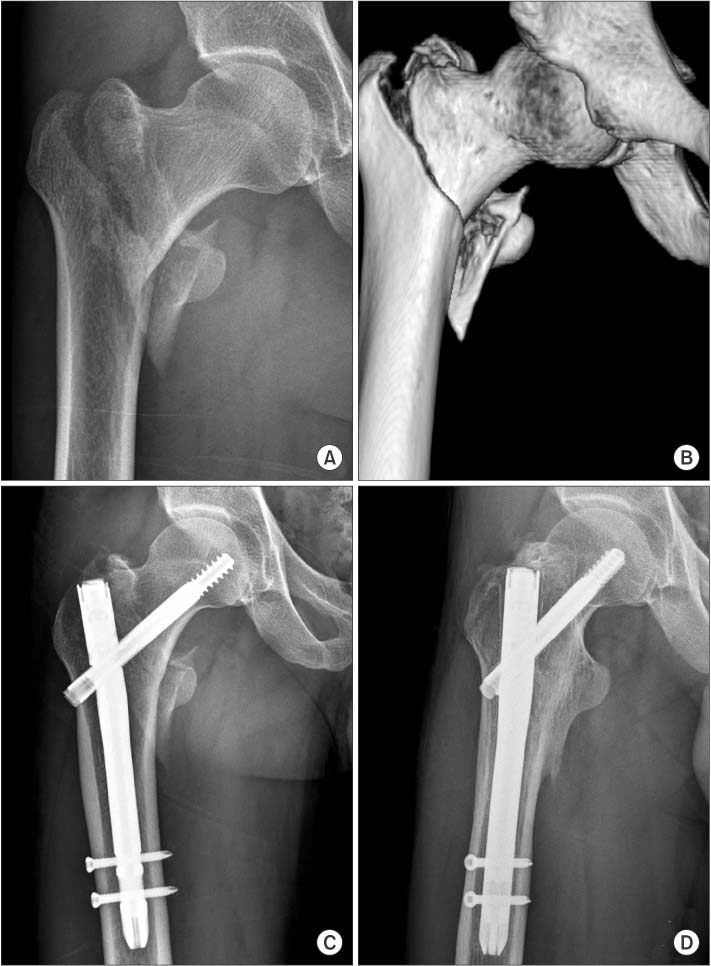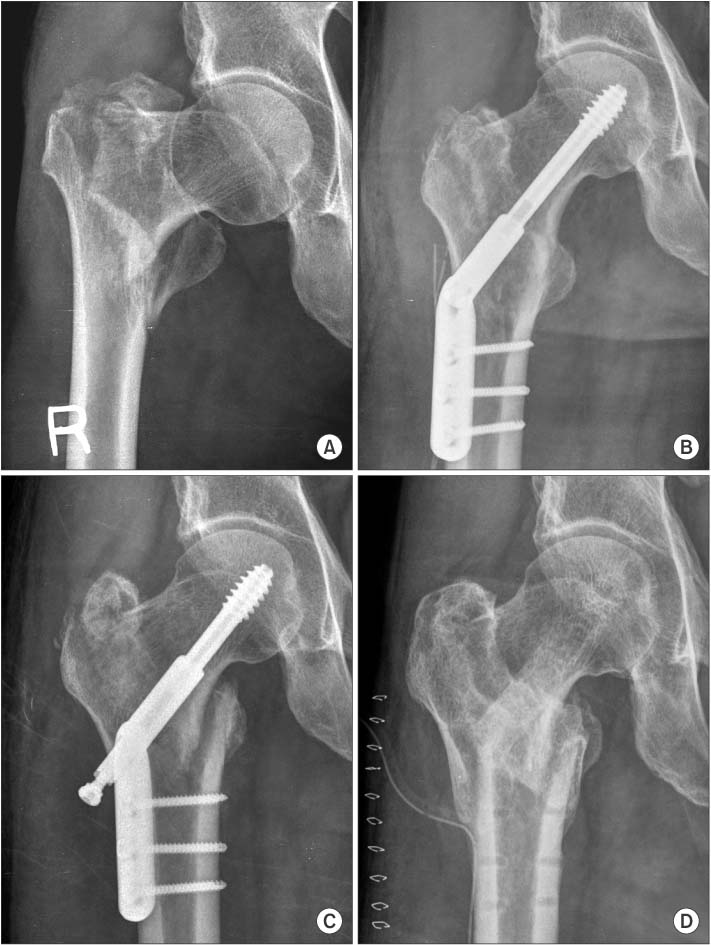J Korean Orthop Assoc.
2016 Dec;51(6):493-502. 10.4055/jkoa.2016.51.6.493.
A Comparison of Clinical Results between Compression Hip Screw and Proximal Femoral Nail as the Treatment of AO/OTA 31-A2.2 Intertrochanteric Femoral Fractures
- Affiliations
-
- 1Department of Orthopedic Surgery, Dongguk University College of Medicine, Gyeongju, Korea. shoulder2011@dongguk.ac.kr
- KMID: 2364301
- DOI: http://doi.org/10.4055/jkoa.2016.51.6.493
Abstract
- PURPOSE
This study compared the clinical results between compression hip screw (CHS) and proximal femoral nail (PFN) after the treatment of AO/OTA A2.2 intertrochanteric (ITC) fractures.
MATERIALS AND METHODS
We retrospectively reviewed 125 cases of AO/OTA A2.2 ITC fracture, treated with either CHS (group I, 34 cases) or PFN (group II, 91 cases) between March 1994 and December 2014. We evaluated the mean operation time, estimated blood loss and transfusion, hospitalization stay, sliding length of lag screw, tip-apex distance, change of neck shaft angle, mean union time, weight bearing time, mechanical failure, and ambulatory ability by the Parker and Palmer mobility scores.
RESULTS
Operative time, estimated blood loss, transfusion, hospitalization stay, tip-apex distance, change of neck-shaft angle, and Parker and Palmer mobility scores were not significantly different between the two groups (p>0.05). However, the mean sliding length of lag screw was 8.15 mm and 3.94 mm for group I and II, respectively, the mean union time was 16.85 weeks and 15.57 weeks, respectively, and the mean full weight bearing time was 4.54 weeks and 2.31 weeks, respectively. The mean sliding length of lag screw, union time, and full weight bearing time all had statistical significance (p<0.05). There were a total of 3 cases of postoperative complications in group I and 4 cases in group II.
CONCLUSION
We conclude that PFN is more reliable than CHS as a treatment method for AO/OTA A2.2 intertrochanteric fracture.
MeSH Terms
Figure
Reference
-
1. Nuber S, Schönweiss T, Rüter A. Stabilisation of unstable trochanteric femoral fractures. Dynamic hip screw (DHS) with trochanteric stabilisation plate vs. proximal femur nail (PFN). Unfallchirurg. 2003; 106:39–47.2. Bridle SH, Patel AD, Bircher M, Calvert PT. Fixation of intertrochanteric fractures of the femur. A randomised prospective comparison of the gamma nail and the dynamic hip screw. J Bone Joint Surg Br. 1991; 73:330–334.
Article3. Kaufer H. Mechanics of the treatment of hip injuries. Clin Orthop Relat Res. 1980; (146):53–61.
Article4. Chung PH, Kang S, Kim JP, Kim YS, Lee HM, Kim JH. A comparison between compression hip screw and intramedullary nail for the treatment of AO/OTA A2.2 intertrochanteric femoral fracture. J Korean Fract Soc. 2013; 26:44–49.
Article5. Fogagnolo F, Kfuri M Jr, Paccola CA. Intramedullary fixation of pertrochanteric hip fractures with the short AO-ASIF proximal femoral nail. Arch Orthop Trauma Surg. 2004; 124:31–37.
Article6. Doppelt SH. The sliding compression screw: today's best answer for stabilization of intertrochanteric hip fractures. Orthop Clin North Am. 1980; 11:507–523.7. Parker MJ, Palmer CR. A new mobility score for predicting mortality after hip fracture. J Bone Joint Surg Br. 1993; 75:797–798.
Article8. Kanis JA, Johnell O, De Laet C, Jonsson B, Oden A, Ogelsby AK. International variations in hip fracture probabilities: implications for risk assessment. J Bone Miner Res. 2002; 17:1237–1244.
Article9. Rowe SM, Bae BH, Park YB, Cheon SY, Kang KD. Mortality following hip fracture. J Korean Orthop Assoc. 2005; 40:1094–1095.10. Kim DS, Shon HC, Kim YM, Choi ES, Park KJ, Im SH. Postoperative mortality and the associated factors for senile hip fracture patients. J Korean Orthop Assoc. 2008; 43:488–494.
Article11. Lee SR, Kim SR, Chung KH, et al. Mortality and activity after hip fracture: a prospective study. J Korean Orthop Assoc. 2005; 40:423–427.
Article12. Hwang CS, Chung PH, Kang S, Kim TH, Kim HC, Kim YS. Comparison between results of treatment of the femoral neck and intertrochanteric fractures: focused on mortality rate and complications. J Korean Soc Fract. 1999; 12:792–802.13. Jensen JS, Sonne-Holm S, Tøndevold E. Unstable trochanteric fractures. A comparative analysis of four methods of internal fixation. Acta Orthop Scand. 1980; 51:949–962.14. Butt MS, Krikler SJ, Nafie S, Ali MS. Comparison of dynamic hip screw and gamma nail: a prospective, randomized, controlled trial. Injury. 1995; 26:615–618.
Article15. Hardy DC, Descamps PY, Krallis P, et al. Use of an intramedullary hip-screw compared with a compression hip-screw with a plate for intertrochanteric femoral fractures. A prospective, randomized study of one hundred patients. J Bone Joint Surg Am. 1998; 80:618–630.
Article16. Kyle RF, Wright TM, Burmstein AH. Biomechanical analysis of the sliding characteristics of compression hip screws. J Bone Joint Surg Am. 1980; 62:1308–1314.
Article17. Babst R, Renner N, Biedermann M, et al. Clinical results using the trochanter stabilizing plate (TSP): the modular extension of the dynamic hip screw (DHS) for internal fixation of selected unstable intertrochanteric fractures. J Orthop Trauma. 1998; 12:392–399.
Article18. Wolfgang GL, Bryant MH, O'Neill JP. Treatment of intertrochanteric fracture of the femur using sliding screw plate fixation. Clin Orthop Relat Res. 1982; (163):148–158.
Article19. Park SW, Baek JR, Moon IS. Treatment of unstable intertrochanteric fractures in elderly patients: comparison between DHS and additional TSP. J Korean Soc Fract. 2003; 16:9–14.
Article20. Leung KS, So WS, Shen WY, Hui PW. Gamma nails and dynamic hip screws for peritrochanteric fractures. A randomised prospective study in elderly patients. J Bone Joint Surg Br. 1992; 74:345–351.
Article21. Chevalley F, Gamba D. Gamma nailing of pertrochanteric and subtrochanteric fractures: clinical results of a series of 63 consecutive cases. J Orthop Trauma. 1997; 11:412–415.
Article22. Kang JS, Park SR, Kim HS, Lee WH, Kim KW, Lee JH. Treatment of intertrochanteric fracture with dynamic hip screw and gamma nail: a retrospective matched pair study. J Korean Orthop Assoc. 2001; 36:423–428.
Article23. Rosenblum SF, Zuckerman JD, Kummer FJ, Tam BS. A biomechanical evaluation of the gamma nail. J Bone Joint Surg Br. 1992; 74:352–357.
Article24. Haynes RC, Pöll RG, Miles AW, Weston RB. Failure of femoral head fixation: a cadaveric analysis of lag screw cut-out with the gamma locking nail and AO dynamic hip screw. Injury. 1997; 28:337–341.
Article25. Kawaguchi S, Sawada K, Nabeta Y. Cutting-out of the lag screw after internal fixation with the Asiatic gamma nail. Injury. 1998; 29:47–53.
Article26. Lindsey RW, Teal P, Probe RA, Rhoads D, Davenport S, Schauder K. Early experience with the gamma interlocking nail for peritrochanteric fractures of the proximal femur. J Trauma. 1991; 31:1649–1658.
Article27. Utrilla AL, Reig JS, Muñoz FM, Tufanisco CB. Trochanteric gamma nail and compression hip screw for trochanteric fractures: a randomized, prospective, comparative study in 210 elderly patients with a new design of the gamma nail. J Orthop Trauma. 2005; 19:229–233.28. Jacobs RR, McClain O, Armstrong HJ. Internal fixation of intertrochanteric hip fractures: a clinical and biomechanical study. Clin Orthop Relat Res. 1980; (146):62–70.29. Steinberg GG, Desai SS, Kornwitz NA, Sullivan TJ. The intertrochanteric hip fracture. A retrospective analysis. Orthopedics. 1988; 11:265–273.
Article30. Gotfried Y. The lateral trochanteric wall: a key element in the reconstruction of unstable pertrochanteric hip fractures. Clin Orthop Relat Res. 2004; (425):82–86.
- Full Text Links
- Actions
-
Cited
- CITED
-
- Close
- Share
- Similar articles
-
- A Comparison between Compression Hip Screw and Intramedullary Nail for the Treatment of AO/OTA A2.2 Intertrochanteric Femoral Fracture
- Excessive Sliding of the Helical Blade and the Femoral Neck Fracture after Insertion of Proximal Femoral Nail Anti-Rotation for Type A2 Intertrochanteric Fractures - A Case Report -
- Treatment of Intertrochanteric Fracture with Proximal Femoral Nail
- Osteolysis Around the Distal Targeting Screw after Using Proximal Femoral Nail Anti-Rotation for Intertrochanteric Fractures
- Treatment of Unstable Intertrochanteric Fractures: A Comparison of Proximal Femoral Nail and Dynamic Hip Screw



